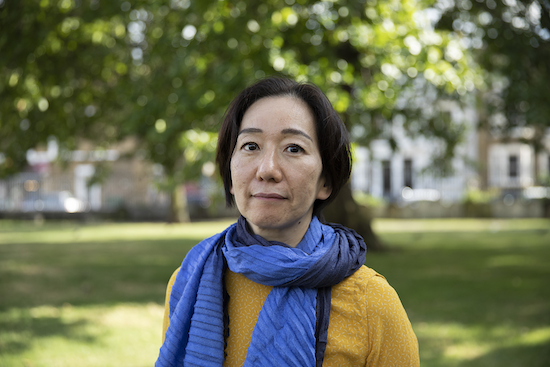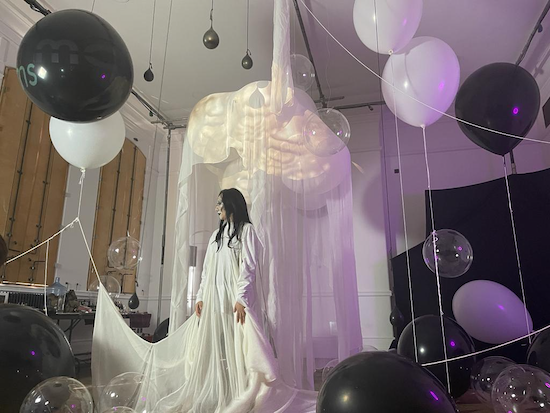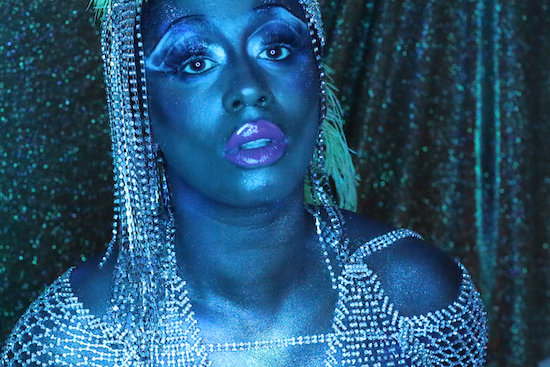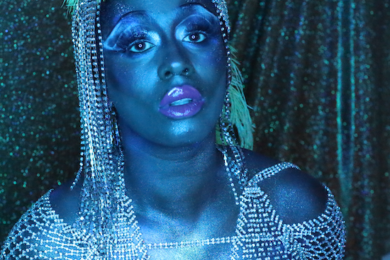Nwando Ebizie, photo by Natalie Sharp
At Colour Factory in Hackney on 15 November, multidisciplinary artist Nwando Ebizie will present the premiere of a new work titled Fall And Then Rise, billed as a “multi-sensory theatrical music experience.”
A blend of music, text and theatrical British Sign Language, the concert is designed to give d/Deaf audiences an equally fulfilling experience with a focus on accessibility. It explores the vibrational experience of sound, conveyed through physical elements like haptic influencers, large balloons which can be touched to feel the vibrations of the music, and a recreation of sound through movement.
The show is presented in three sections. The first, ‘In Love’, is described as a romantic prelude inspired by falling into a doomed love. The second, ‘Teeth’, refers to “the horror of teeth falling out.” The third, ‘Rise Of The Clowns’, is inspired by a section of Angela Carter’s Nights At The Circus, and takes the form of a “crazed clown klezmer dance.”
The music itself grew out of an old poem by Ebizie, choreographed alongside the Deaf performance artist Chisato Minamimura. Elsewhere the show takes inspiration from themes such as Haitian Vodou and Jungian theory.
The piece was commissioned by London Sinfonietta and will be performed by their ensemble with conductor Chloe Rook, alongside Ebizie and Minamimura. Ebizie is an artist of the 2019-2022 cohort of the Sinfonietta’s Writing The Future scheme, which offers early career music creators the chance to develop a new piece in partnership with its ensemble and established mentors
To purchase tickets for the show, and to find out further information, click here. tQ also caught up with Ebizie over the phone for further discussion about the project, which you can read below.
Fall And Then Rise is multi-faceted, could you tell us how it developed?
Nwando Ebizie: So in about 2019, I was doing this gig at Bounce Festival in Belfast, which is a disability arts festival. I was doing another show with the persona I had at the time, Lady Vendredi. All my gigs are like gig-theatre, but the basis of it is always ritual experience, and for this experience there was a lot of stuff about trauma and letting go of it. I wanted to have this feeling of lightness and air, so I was working with all these different inflatables. I ended up emerging from a giant egg and putting on a giant inflatable costume. As part of that, there was a moment in the piece where people hugged balloons and I asked them to whisper their fears into them. Afterwards, some d/Deaf people came up to me and said that that bit was really interesting to them, because some of them had been taught in school to hold a balloon and whisper into it so you could feel the vibrations of your voice. I’ve done quite a lot of sci-art projects with neuroscientists and psychologists, and it was always around perception but more like visual perception, not so much with audio. I wanted to create a piece that prioritises the d/Deaf experience in music culture.
I also had written this song when I was a kid, this cinematic love song, something that I never was able to find [a place for]. It became the first bit of the piece, and then I started working with this artist called Chisato Minamimura, she’s a deaf dancer and movement artist. I gave her the text and we worked to translate it into British Sign Language, which was a really fascinating process in and of itself. I’ve been learning BSL and it’s very different from English, you can’t do a one-to-one translation. She translated it into this dance piece, because BSL also has this choreographic logic to it. I’m a dancer as well, I really like to work backwards from the dance to the music. So what is brought out in the musicality and the rhythm and the expression of the dance, I created that in the music.

Chisato Minamimura, photo by Mark Pickthall
It’s really fascinating to think of music as a tactile thing, and of sign language as a dance… it’s interesting to break down the boundaries between the senses each art form is supposedly designed to effect.
NE: I think it’s really interesting. We’re also using these vibrating platforms attached to steel decking so you can lie on them, and we’ll run the amplified sound through them so you’ll be able to feel the vibrations of the music. It’ll be separately mixed for vibration, so you’re not only getting the low end and the percussion, you’re getting the high end and the melody as well. We tested that out in the r&d and I loved it. I’m someone whose perfect concert experience would be lying down anyway. It might be interesting if you’re d/Deaf, and it might be interesting if you’re hearing too. Things are changing, but I think it’s really shit that generally in art structures, anything to do with accessibility is like it’s add-on. That it’s the ‘community’ section. It’s never the serious bit of your output, the serious bit of the work, There can a bit of like, ‘Eurgh, we’ve got to do it for the funding.’ Whereas I think it’s really fucking exciting.
We’re promised ‘experimental dance meets Klezmer, and new music meets romantic ballads’. Could you tell us a bit more about how it’s going to sound?
NE: It’s probably the most ‘classical’ thing I’ve written. The beginning’s quite experimental and descriptive of the movement. It’s like a feeling of anticipation. When I was writing I was thinking a lot about Shostakovich’s fifth symphony, and quite a lot about Mahler, so it’s probably got some edges of those pieces. The klezmer thing came in because I kept on thinking about an old friend of mine and his really cool clarinet klezmer playing. That also came in because of an Angela Carter reference.
Carter’s Nights At The Circus inspired a lot of the performance’s third act. Can you tell us more?
NE: I fucking love Angela Carter, the scenes in her writing are just so visual to me, so real and alive. I had this scene that’s really haunted me for years. It’s at the end of the book, set in Siberia, where this whole load of clowns go and get swirled up into this snow tornado. It also kind of transformed in my head to being about revolutionary fervour, a changing of epochs, so it’s a nod to that. I had a scene of different spirits from different Black ritual cultures, meeting to create this revolutionary moment. But they’re also meeting in Siberia as well. Where did the klezmer come in? I can’t really remember, but when I write things it kind of makes sense at the time! But that section’s like a dance piece, with edges of 19th century folk dances from Eastern Europe.
As well as Chisato Minamimura you’ve got Nat Sharp involved too. What was her role?
NE: She’s a good friend of mine, and she lives nearby. We started working on it quite a while ago, so she did the design concept. I said how I wanted all these balloons in it, and so she made these really beautiful designs. She made this big, beautiful costume, a silk, voluminous dress that interesting movement can happen with. She also did all the filming for it, because there’s also going to be visuals projected onto balloons. We did an r&d together at a small space at the Battersea Arts Centre.
Do you see the Colour Factory gig as an end-point, or is this an ongoing project?
NE: It’s definitely the end. It’s got to end! But hopefully we’ll do it again. But the research is always ongoing. There’s questions that have come up during this, like ‘What if I wrote from a different perspective, after now beginning to understand BSL?’ But generally the idea is that you come into this one hour experience, and that when you leave, you feel like something’s happened, something’s changed a bit in your inner world. It’s simple, but there are these interludes, like the ‘Embrace interlude’ where you embrace different things. It’s those ritual elements which I generally work with. I think art is a good way into ritual experience.

R&D sessions for Fall And Then Rise
Can you expand on what ritual experience means in relation to this show?
NE: The main difference between ritual and performance is that the roles are more delineated. People have an invitation to perform roles other than audience and spectator; it’s not spectacle. What the possible impact of that is on the individual and the collective is what’s interesting, I think.
The performance was commissioned for the London Sinfonietta, and you’re part of their Writing The Future Scheme. How has that been?
NE: I got this commission during lockdown. And then the idea just grew so big, and I would say that I think they’ve been really great at accommodating the expansiveness of what I’ve been wanting to do. I don’t know what the Writing The Future scheme is for the other composers, but they’ve definitely been supportive in wanting to facilitate the vision.
You’re always busy on multiple fronts. What else are you working on at the moment?
NE: Mostly on an album at the moment, and I don’t know if I’m allowed to say this, but I’m also working on a short film with Opera North and Sky Arts. I’m also composing a piece for The Hermes Experiment which I’m really excited about. My main thing, which is ever ongoing, is working on this day long opera experience. I’ve been working on that for ages! The logistics and everything else are really insane. It’s based on the life and works of Hildegard Von Bingen, where you’re moving through installations, sculptural pieces, eating, drinking, being hypnotised and all sorts. I’ve also got this exhibition on at the moment at Moda in Leeds, called This Is A Forest. After this it’s going to feel quite quiet!



